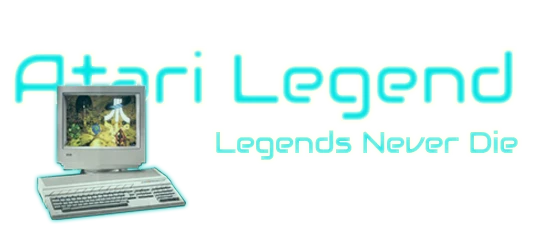

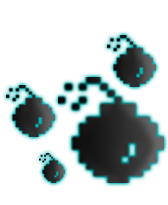





Doodlebug is one of my all time favorite platform games on the Atari ST. A little known game, which for me is a hidden gem. Its creator Adrian Cummings, an Amiga developer, tells his intriguing story of ups and downs, and shares a lot of details in the making of this beautiful game.
There is currently no profile available in our database
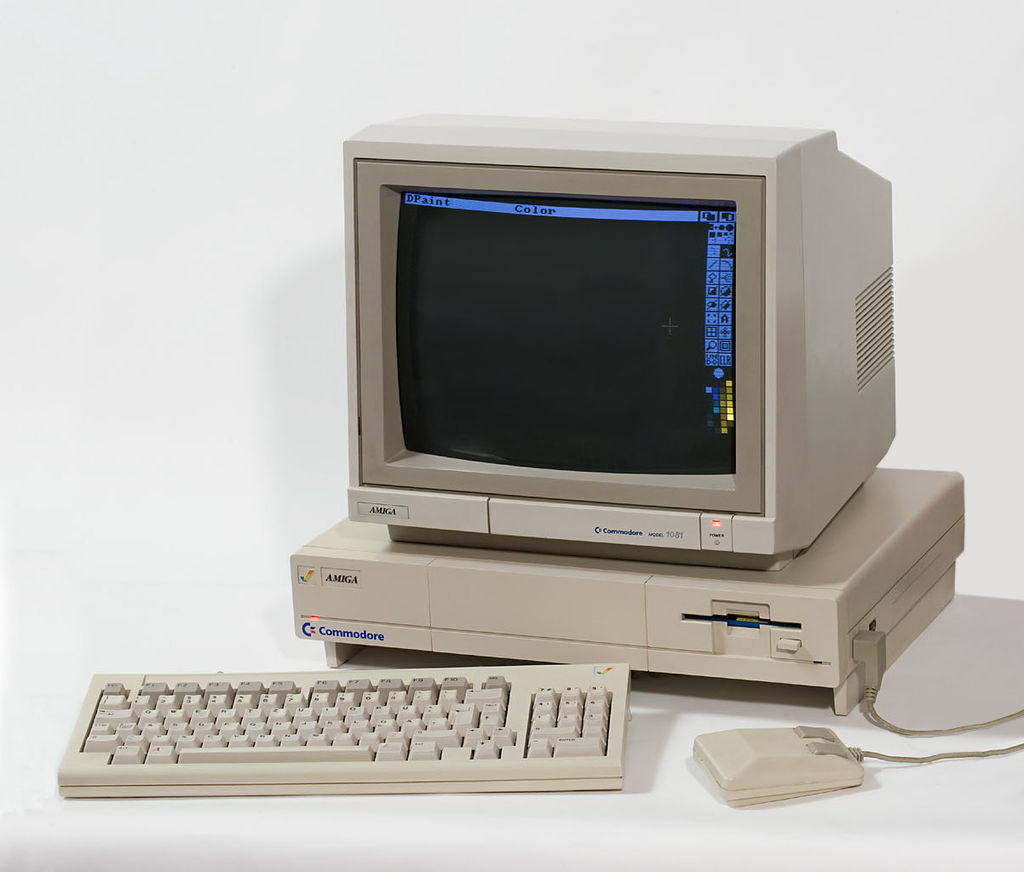
The beautiful Amiga 1000. Adrian has always been, and will always be a complete Amiga nut. Although he did own an ST ... briefly ;)
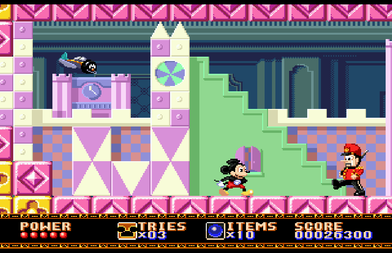
Castle of Illusions on the Sega Megadrive was a great platform game and a definite inspiration for Doodlebug.
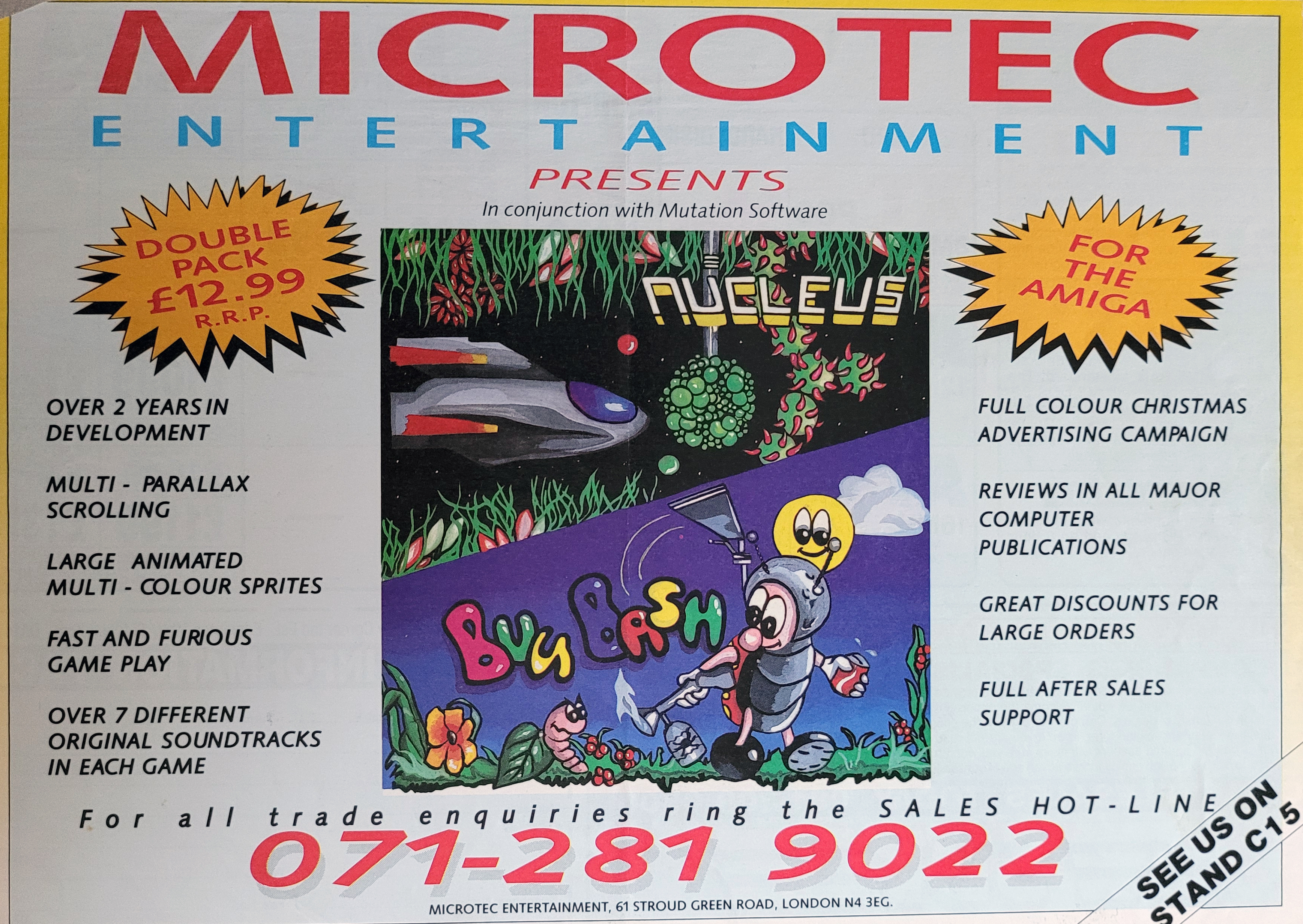
On the Amiga, Bug Bash was released by Microtec as a double pack offering, containing another game made by Adrian. Nucleus was a beautiful side-scrolling shooter.
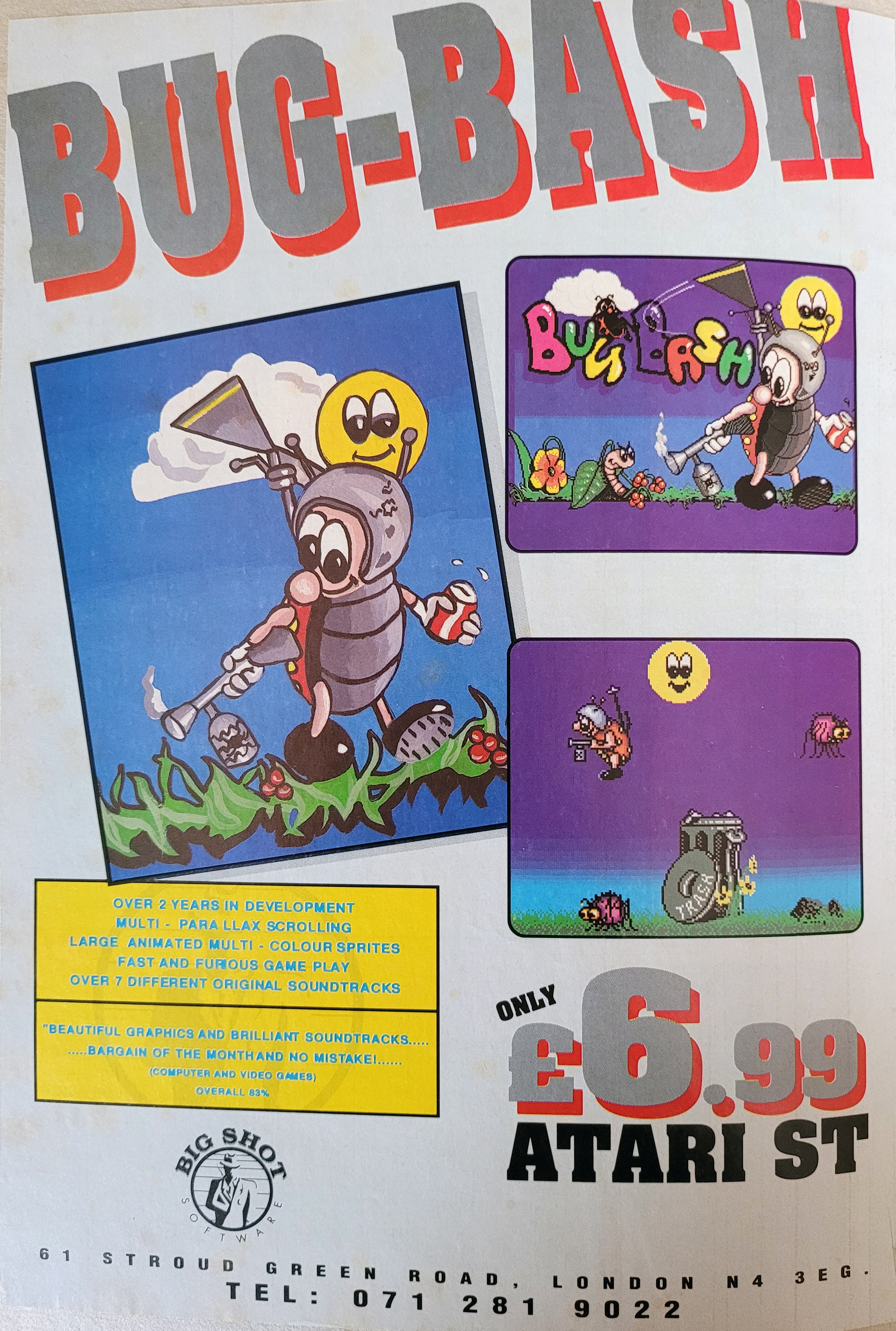
With the release of Bug Bash on the ST, the publishing company Microtec turned into Big Shot Software.
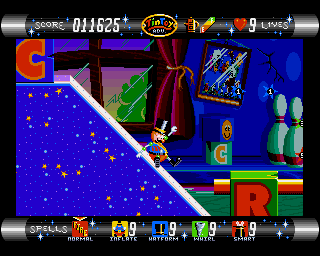
For Doodlebug, Adrian did not manage to program 'contour tiles', creating a slide effect. He did find out how to do it in his next game Tin Toy, an Amiga 1200 exclusive.
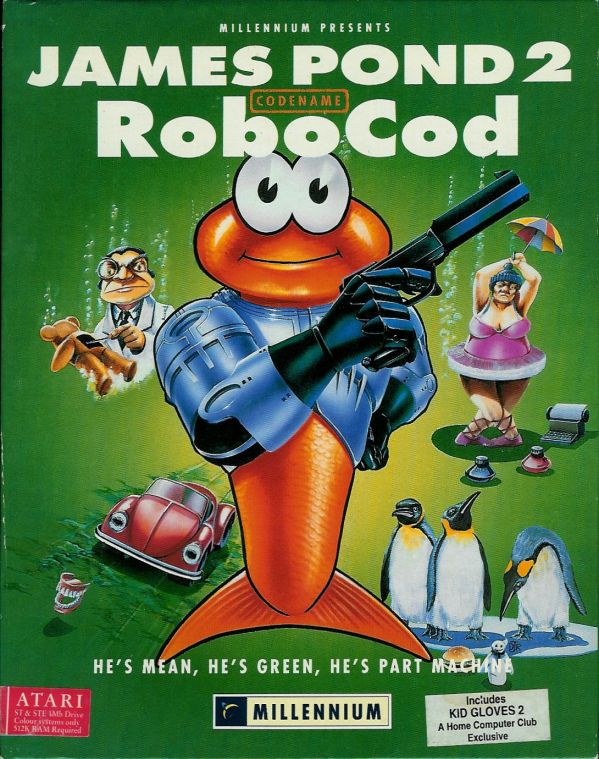
Robocod on the Amiga featured beautiful parallax scrolling. When Adrian noticed it, he wanted to copy this effect for his Doodlebug game.

This is Jeremy Smith, the head of Core Design back in the day. He was immediately interested in Doodlebug when Adrian showed him a working demo.
1) Hi Adrian. Can you tell us a bit about how it all started for you? The very beginnings of it all. What was the first ever computer you owned? When did you know you wanted to become a game developer? And how did you end up with the Amiga?
Sure, it all started like most in the early 80's using a CBM PET at school and wanting to buy a Nascom II micro computer, but couldn't afford it as a young teen. Instead I had a paper round at the local newsagents that allowed me to save up and buy a Sinclair ZX80 kit. I remember I had not long been in a pretty bad car accident, so my arms were in plaster for months. I built the ZX80 kit with a soldering iron taped onto my plaster cast - it was very tricky. I recall switching it on for the first time and just got a black screen. Looking with an eyepiece over the whole PCB, I later found a blob of solder over two pads that shouldn't have been joined. I fixed that and it finally worked - huzzah :D
I wanted to write games after playing several, mainly by visiting the arcades and playing the early arcade machines - mostly vector-based machines at first like Space War and later Asteroids.
After owning several other machines in between like the BBC Micro and C64 etc, the Amiga came much later of course and was the result of waiting what seemed like an age for the dream machine to make it to the UK marketplace. I finally bought (with the aid of a bank loan) one of the first machines in Hampshire, UK along with my mates... the mighty Amiga 1000. Great times. I actually couldn't wait to buy the Amiga so bought an Atari ST beforehand just to make do while I waited - played a lot of SunDog on that and drew a fair bit with Degas and NEOChrome too. I had DevpacST too but back then didn't really get on with it.
2) What was the first game you ever created? Was it Bug Bash?
I created quite a few game demo ideas and concepts before I reached Bug Bash. That game was the first one that I managed to complete and sell commercially though yes.
Before then I also worked with mates Rob Brooks, Dave Boggust and Jason Lihou on many game ideas too like a shoot'em'up demo Outlander (Amiga) and others before I went it alone so to speak.
3) You did a lot of game demos before working on Bug Bash, most notably probably Outlander and Outlander 2. Was there ever anything released of these demos? Do you still have some screenshots or anything? I found another interview in which you mention Outlander was based on the arcade game Space Force. Is this correct? Do you remember?
Regarding the old game demos and stuff like that, most of it can be found online here...
Interview & Games.
4) You have said in the past your favorite game genre are platform games. Do you remember where that started and do you have an absolute favorite in this genre?
Love a good platformer me for sure. Early on 8-bit era games like Burger Time (both BBC Micro & Arcade), Bugaboo the Flea (C64) were a favourite plus later Sonic the Hedgehog, Castle of Illusion and Quackshot all on Megadrive were later great inspirational 16-bit era games. My favourite games of all time are Marble Madness & Robotron (Arcade) tho.
5) Can you tell us a bit about the history of Bug Bash? Where did the idea come from?
My mum bless her, had this idea about a friendly bug character clearing up a messy garden and eliminating garden pests. My mate Dave Boggust came up with a suitable name for a game. I married the two together and Bug Bash the game was created ![]()
6) Bug Bash was released by Big Shot Software. You describe that period in your game developing career as a dark one, in which you almost quit as a game developer. Care to elaborate?
In the early days publishing a game on the Amiga/Atari ST was still very wild west, I guess, and both the then publisher I found in the back of a magazine and myself were very green in that respect. I expected to make some good cash from the Amiga release of Bug Bash and it's 'double pack filler' game Nucleus, but it really just didn't happen as imagined and that event alone totally destroyed my dream of being a games developer in every respect back then. I had a good job that I'd just left beforehand working in the heating and ventilation industry as a software engineer, after a 2 year stint on the electrical control panel drawing boards as a draughtsman before that. Everything just seem to spiral out of control from there and I ended up in bad mental place and state for about 2 years with little savings. When I met the publisher they were called Microtec Entertainment. I lost control of the game rights to a great degree and then they rather suddenly became Big Shot Software overnight when the Atari version was ported by Rob. That game represents a dark period in my life where personal friendships were also tested to the limits sadly. I ended up selling the Amiga versions through a PD library called Amiganuts United, I think it was to make little extra cash. Not good really and tough times all round.
7) Regarding Bug Bash, you mention you ended up selling the game through a PD library. But were you allowed to do this even though it was published as a commercial game?
Yes, I was given a small advance by the then publisher Microtec at first to hand over the game(s). After endless chasing and about a year of no royalty payments or anything further, I decided to put rebranded versions of the game(s) into the Public Domain. I made a small amount of cash from that which basically kept me in packets of fags/cigs each month and that was about it. I had contacted all the magazines that I saw adverts for those games in, only to find they hadn't been paid either LOL. It really all was a sad waste of time looking back. The guy who ran the PD library became ill himself I recall and that was that pretty much. The games had been pirated to death by then also, so it was worthless to pursue it all any further from that point onwards. Very poor personal experience and turnout all in all, but I eventually chalked it up and moved on to greater things.
8) Also, Bug Bash has a double pack filler called Nucleus. Do you mean the game was released together with the Nucleus game for the price of one game?
Yes, Bug Bash had a 'box filler' game packaged with it called Nucleus which was a horizontal shoot-em-up. The publisher thought that sales would be better on a double pack offering, so I produced two games for them at once which turned out to be twice as painful for me I guess in the end when I eventually got royally shafted. I'd seen Flimbo's Quest on the Amiga that featured 32 colour parallax scrolling and thought I'd do the same using the Amiga blitter heavily to reproduce the same effect, so it ended up looking quite nice, if nothing else.
9) You have told me about the history of Bug Bash. But I was wondering, where does Nucleus exactly fit in? I mean, by the end of 1989 you gave up your full time job to start making games (Mutation Software). You created Bug Bash. But Microtec thought it would be a good idea to release a double pack. So Nucleus comes in the picture. When was this game made? And how did this start? You were inspired by Flimbo’s quest. But did you create this game because Microtec asked you? Or did you already have something ‘lying around’? Did you make Bug Bash and Nucleus both in 1990? I checked some YouTube videos of Nucleus and the game looks incredible. I don’t understand how you can make both these games in less than 1 year (all code, graphics, music)?
I actually wrote most of Bug Bash (Amiga) in 1989 and also some of it while I was still working full time. Nucleus was produced in about 4-5 months just after, in early 1990 I recall. I had taken Bug Bash to a few publishers before Microtec, as by then it was almost finished enough to show them. They mostly liked it but none signed it up. Nucleus was only created to fill the Amiga double pack offering and it was never produced for Atari ST of course. There was to be a third game called Egg (Amiga) for Microtec, but as things turned sour it never came to be. So to sum up, Bug Bash took about 9 months and Nucleus took about 4-5 months between years 1989 and 1990.
10) On the Atari ST there was a special demo/preview version of the game for the magazine ST Action. Are you aware of this?
I don't recall that no and was probably pretty out of it by then to notice I guess just trying to get my life back to some semblance of order mostly.
11) Let’s talk about Doodlebug. You may not know this, but Doodlebug is a bit of a hidden gem on the ST. For me, it is the pinnacle of console quality platforming on the system, together with Zool. I believe Doodlebug is also one of your personal favorite creations? Please tell us about the history of this project. Where did you get the idea? What do you remember about it all?
WOW that is really cool you think that, thank you! Doodlebug was a follow-on idea really for Bug Bash but more as a true platformer concept. Coming out of my bad place on a metric pile of antidepressants LOL, my brain and game imagination started working once again. I was to take the bug idea further by adorning him with magic pencils so that he could draw his way out of trouble. Doodlebug came to pass and took me about 9-10 months work to create on Amiga. Rob had helped greatly towards this goal by showing me software sprite and tile scroll techniques on Amiga that would change the way I was writing games before. Magic moment right there that was.
12) Doodlebug was subtitled as Bug Bash 2, yet the games are incomparable in quality. Doodlebug is much better. Bug Bash even had a more shoot ‘em up feel to it. A totally different experience. Why did you want to link these games in that way?
I know it was a bit bizarre to link those games looking back. Doodlebug was indeed born from Bug Bash in terms of the main character at least, which I further developed after playing many other games myself. I just wanted some form of game continuity and link I guess.
13) This may be a noob question coming from an Atari ST guy. On the ST, horizontal scrolling is always a thing, since we don’t have the hardware capabilities on a normal ST. The Amiga has it all. But what do you consider the most difficult technical achievement in creating Doodlebug on the Amiga. What are you most proud of? And is there anything you would have done differently, looking back?
The hardest thing(s) I can recall creating Doodlebug on the Amiga was learning how to create contour tiles and the 5th bitplane scroll also like Robocod had. The contour tiles never made it into the game. If you look you can see levels where they were to be included but I was forced to use step tiles, as back then just couldn’t fathom it. The 5th bitplane scroll on Amiga A500/A1000 using the blitter was a mini-nightmare. On looking, Rob had a total Eureka moment with pen and paper, and it just started to scroll smoothly in parallax at last with a seemingly minor change to the code.
14) Can you go into more detail? What exactly is the 5th bitplane scroll?
On the regular OCS/ECS Amiga there are upto 6 bitplanes each can represent 0 or 1. Using 4 bitplanes gives you 16 colours in 4 bits per pixel. Using 5 gives you 32 colours per pixel. You can't use all 6 bitplanes unless you put the Amiga into 8 colour dual playfield mode though, so in reality you can only have up to 5 bitplanes together (You can use 6 bitplanes also in HAM mode, even though Amiga HAM mode is pretty useless for games in reality). The 5th bitplane in Doodlebug uses the top 16 colours of the 32 colour palette using 5 bitplanes. By setting the top 16 colours the same as the bottom 16 colours the bit combination actually presents as if the 5th bitplane appears behind the others, when in reality it is not. That is the best I can describe it anyway ![]()
The scroll register will allow all 5 bitplanes in this case to scroll together, but to scroll the 5th bitplane slower than the front 4 planes, then you have to blit the plane into the screen whilst allowing for the shift using the Amiga blitter's barrel shifter - that is the tricky part in practice. So in conclusion, The 5th bitplane blitter scroll uses the Amiga blitter barrel shifter to scroll the parallax plane of clouds and toys etc in Doodlebug. But with clever use of the top 16 colours, it is possible to 'blend/mask through' the graphics on screen so it appears in the rear of the screen (just like Robocod and later Tommy Gun too). You cannot put the priority of the 5th bitplane on Amiga so it appears behind the other 4 at hardware level. This is why it is blit/scrolled to the screen with the colour method above. Like most things in life, it's not easy to do unless you know how ![]() Robocod did it first, Doodlebug did it 2nd.
Robocod did it first, Doodlebug did it 2nd.
15) And what do you mean with ‘contour’ tiles?
If you look at the first level of Doodlebug you will see 45 degree slopes with steps inserted on them. That is where contour tiles would have been used but were never included in Doodlebug. There is a 45 degree slope just before you meet the NPC girl with flower sprite in the first level of that video as an example. I just couldn't work out back then how slopes and curves were implemented at code level, like eg. in Robocod. That is where I gave up with contour tiles and put step blocks on the slope instead ![]() Later on I fathomed how to do it on another game.
Later on I fathomed how to do it on another game.
16) Did you design all the graphics yourself? And what tools did you use to make them? What/who inspired you?
Yes I sat for many hours/months with good old DPaint on the A1000 drawing the sprites and tiles etc for Doodlebug. Mostly the many games I had played to date were a huge inspiration to create the entire game on Amiga at first, with a nod to some of my past efforts of game demos that never made it to commercial release too.
17) You mention all the beautiful graphics of Doodlebug were inspired by other platform games and also some of your previous work, game demos that never made it commercially... etc…
I had a lot of stuff stored on hard drive that was sadly lost in the early to mid 90's around the time I was working on the game Fantastic Island for Core Design, just after CyberPunks. Many years later I released what I had left to the Amiga scene in terms of old stuff like that. Some of the surviving data was Beach Head I, Beach Head II and Raid Over Moscow graphics for Amiga / Atari ST (a conversion I was previously also doing with Rob) but was never completed. An Amiga scene acquaintance later picked all that up decades later and finally produced and released Raid Over Moscow for the Amiga in 2020 I think it was. I've long since lost most of the pencil design work stuff, code and graphics I did though for Bug Bash though. All gone sorry.
18) In what programming language was Doodlebug made?
All 68000 assembler using Devpac 2. Before that I recall I'd used SEKA assembler which was somewhat entertaining to actually code with to say the least LOL.
19) Something I forget to ask. The music, you have composed everything yourself? Are you a musician?
I tended to write all my own computer game music back then and still do to a great degree though not always now. I consider myself to be an amateur musician by any decent musical standards LOL. I like to write catchy tunes and feel I can at least do that quite well now. Most of my game work was done on various Amiga trackers down the years. I had played in a few bands in the very distant past and can honestly say I owned a lot of hardware synthesizers and keyboards in the years gone by. I tend to use computer DAW-based VSTs now when the mood takes me though. I still use Protracker on Amiga from time to time on my hobby Amiga and release stuff like Wiz (2020) and CyberPunks 2 later in 2023. Overall I dabble in music but am not a music professional by any stretch of the imagination ![]() The remix was supposed to go onto a game remix CD that some guy was producing I recall, but I lost touch and not sure if the actual CD happened or anything. Glad you like it though thank you
The remix was supposed to go onto a game remix CD that some guy was producing I recall, but I lost touch and not sure if the actual CD happened or anything. Glad you like it though thank you ![]()
20) Your development company is called Mutation Software. Why?
As a sideline later, we used to sell commercially packaged computer games at a car boot sale on Sundays and on leaving the venue after packing up for the morning there, I spotted an old shoe box with Mutation on the side of it. I thought that's it, I will call myself Mutation Software as everything was seemingly ever changing and mutating from one idea to the next in terms of the games I was looking to create.
21) Your games were converted to the Atari ST by Rob Brooks. How did you two meet?
I first met Rob at the GB Microland store where he worked for a bit. I bought my Amiga A1000 there and the rest was history. Rob later went on to work with Images Design where he worked on the Wonderboy Amiga/Atari ST port with Rob Hylands etc.
22) Have you ever considered yourself doing the conversions for the ST?
Simple short answer = no ![]()
23) Was Doodlebug a successful release? On the Amiga and the ST? Do you have any idea how many copies were sold? It got a nice 83% in ST Format, at the time of its release there was quite some competition with games like Fire and Ice, Addams Family and Zool. But for me, Doodlebug stands out!
By the time I had released Doodlebug with publisher Core Design Ltd., it sold between around 15000 to 20000 copies on Amiga and Atari ST combined I recall. The competition was pretty extreme by then yes. I really liked Fire & Ice for the wonderful character design and gameplay. Zool for the technical coding ability on display and Addams Family for graphics.
24) Do you remember who created the beautiful boxart?
Doodlebug’s box art was superbly airbrushed by Brian Lenton for Core Design. I still have the old A2 game poster framed on my wall. After all these years my eye is still drawn to the fact that Doodlebug's right arm looks somewhat dislocated at the shoulder joint in relation to his body hehe ![]()
25) Ok, we need some more clarification here. You seem to have worked on Wonderboy in Monsterland. When looking at the Hall of Light page, I read this :
“In fact it's where 'Laura P. Paul' came from in the credits (which I later used a lot in my own game credits TBH) because a 'lot of people' worked on it in the end in reality to get it out the door at Images Design."
So, Laura P. Paul is not a person? Rob Brooks is credited as programmer. Did he do the ST version? Any idea?
Laura P. Paul is a fictitious name for a 'lot of people'. I worked briefly on some projects at Images Design on several occasions. On Wonderboy in Monsterland I created the original 'big eyed' title screen for the Amiga/Atari ST port of the arcade machine version. A lot of people came and went at Images and many worked on multiple projects to get them finished and out the door back in the day. I met many like-minded, sometimes strange but clever people back then and learned a lot about creating games within the early growing games industry. A huge difference programming boiler-monitoring software to writing computer games anyway ![]()
26) By 1996 you started working on the Amiga 1200 and released the beautiful Tiny Toy, based on the Doodlebug engine (Sadly, there was never an Atari Falcon conversion). After that you left the Amiga scene. What did you do then?
Yes that's correct. I created and wrote Tin Toy on Amiga (AGA) after playing Clockwork Knight on a friend's Sega Saturn. After that I did Tommy Gun and Castle Kingdoms for Amiga (ECS/AGA) machines. I left the scene after that to work on PC games and later mobile games of course which was the new, next big growing thing. Back then at least.
27) In 2020, you decided to come back to the Amiga and released the game Wiz. What made you change your mind? And would you maybe even consider doing an Atari ST conversion?
I'd always kept a finger in the Amiga pie and also retained my interest and kept my machines working in the background. It was really Tony Aksnes that contacted me on social media to come back and write another Amiga game. I then spent about 11 months creating Wiz for Amiga (AGA) and published it myself. There was even a special limited run of 50 big glossy box versions that went to on sale alongside the regular mini-jewel cased and digital versions. It never sold in big numbers by past standards of course, but it did OK really for an all new Amiga game in 2020 at least.
28) Apart from the Amiga, what are you up to these days?
Currently my wife and I bought an old house in Scotland and am about 8 months into an 18-month renovation of the property. Most of my little remaining development time has been spent updating lots of mobile apps to comply with latest store policies. I am hoping to return to Amiga development in 2023 with another new title, but had to stop work on it in 2021 when we moved here. Nothing is set in concrete just yet though.
29) Just for fun. If you could have a drink with anyone, alive or dead, who would it be and what would you ask? Who do you look up to?
Carl Sagan for the novel and later film Contact which is a favourite of mine and my wife's. I would no doubt ask him many questions about our place in the universe and everything in it. I'd also like to invite Elon Musk to a dinner party and tap him up for a few quid after a few bottles of wine perhaps ![]()
30) Even though you are an Amiga guy, do you have any words of wisdom, anything at all you like to share with the Atari ST scene?
Looking back, just think how much better the original Atari ST games would of been with a scroll register. Preshifted tiles to scroll = bit cheese init.
Thanks for everything Adrian!
For more info on Doodle Bug, check out the fullblown documentary and the extra video created by Rob Brooks discussing the scrolling of the Atari ST version of the game.
August 5, 2025 by grams88
Martin Brownlow is a living legend. Best known among ST fans for creating the beloved PD/shareware classics Grav and Grav 2, his games are still cherished by many to this day. From a young age, Martin knew he wanted to make games for a living...and he made that dream a reality. In fact, he’s still doing it today. Discover the full story and much more in this exciting new interview.
October 4, 2024 by grams88
Stacey Jamieson began his career at DMA Design, working on titles such as Oh No! More Lemmings, Walker, GTA and others. Over the years, he moved on to Electronic Arts (EA), where he contributed to major games like the Star Wars Battlefront series, Mass Effect, and Need for Speed. Today, he is the co-founder of Expression Games, where he continues to pursue his passion for game development. What an exciting career!
July 29, 2024 by grams88
Who doesn't love a good underdog story? Chris Sharp is a noteworthy apprentice of the renowned François Lionet, as he mastered the art of coding with the almighty STOS Basic. Chris crafted a few games for our cherished ST, including fan favourites like Magic Tomb and the Freaked Out series. Intrigued? Dive into our interview to revisit the era when game development could still be a solo endeavour.
July 16, 2024 by grams88
When Sega released its Master System, it came bundled with the game Alex Kid. To this day the game remains very popular, loved by many. One of those people is Terry Lloyd. More so, Alex Kid was the main inspiration for the Atari ST platform classic Axel's Magic Hammer. But that is just one of his many accomplishments. Terry has been around the block. Working as an artist and game designer at the beginning of the 80's for Gremlin Graphics, he then moved on to Core Design, which he helped get off the ground. During the 90's he contributed to founding the company Malibu Interactive. On the Atari ST, Terry's resumé include Dynamite Dux, Car-Vup, Rick Dangerous 1 & 2, Torvak the Warrior, WarZone and many more. Read all about this veteran of the games industry in this exciting interview.
April 18, 2024 by grams88
It doesn't always have to be about computers, coding and graphics. Adrian Powell, the artist behind the original Lemmings game, crafted all its artwork, including box art and promotional materials. His passion for painting lemmings has persisted over time and he is still painting lemmings to this day. Powell's work remains influential and has helped selling millions of copies of this classic (ST) game.
Currently 0 registered users online
In the past 24h there were 1 registered user online